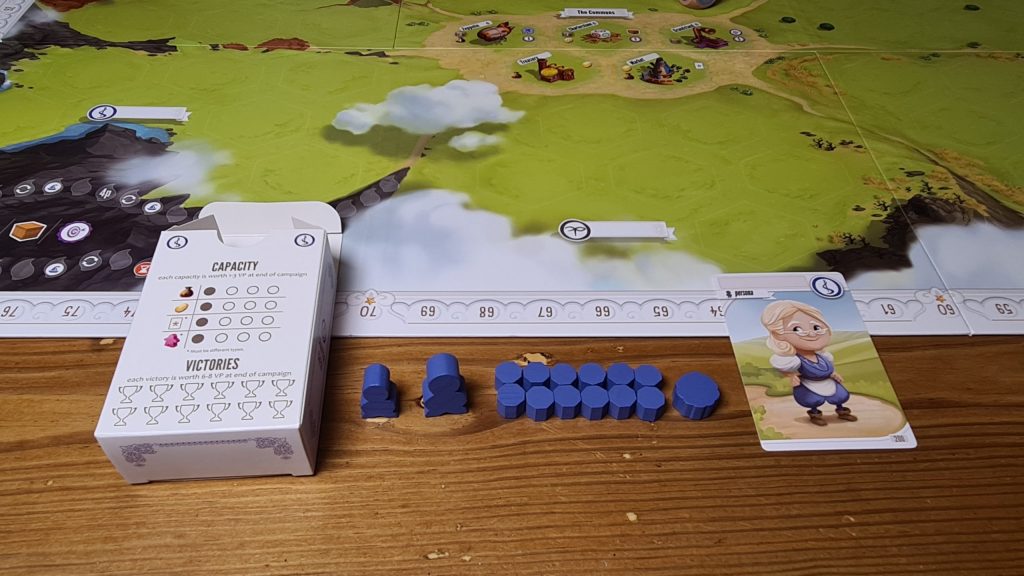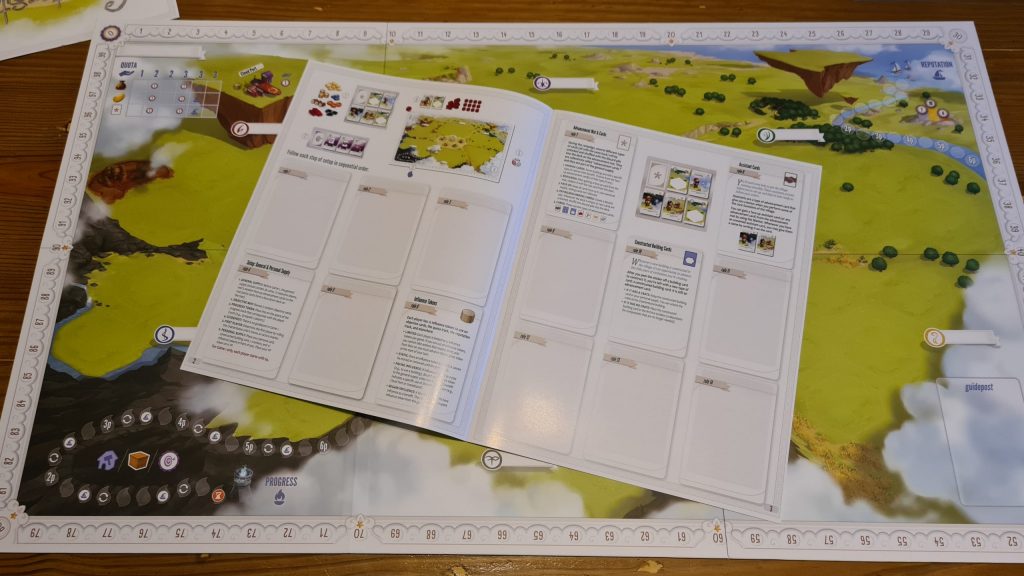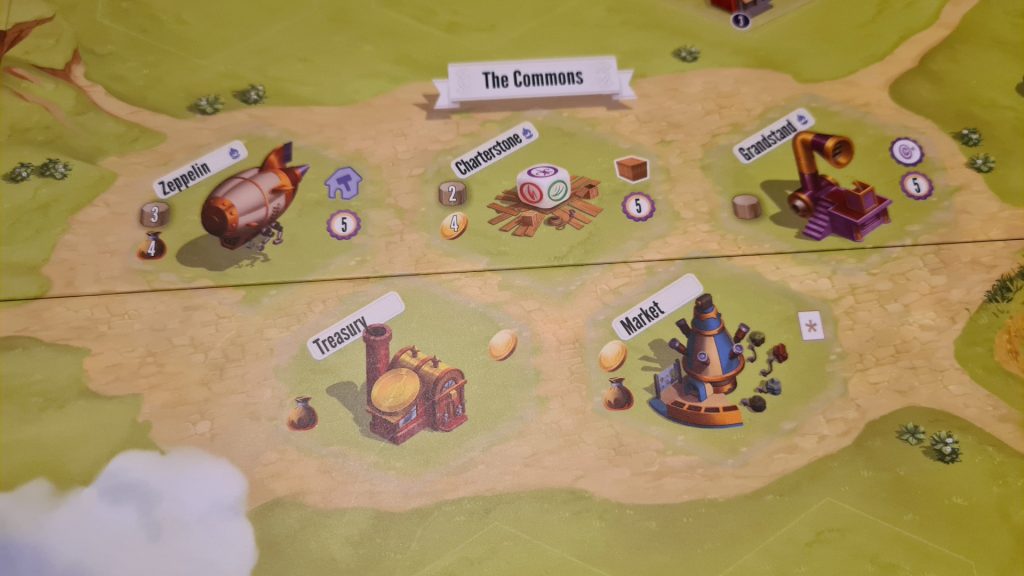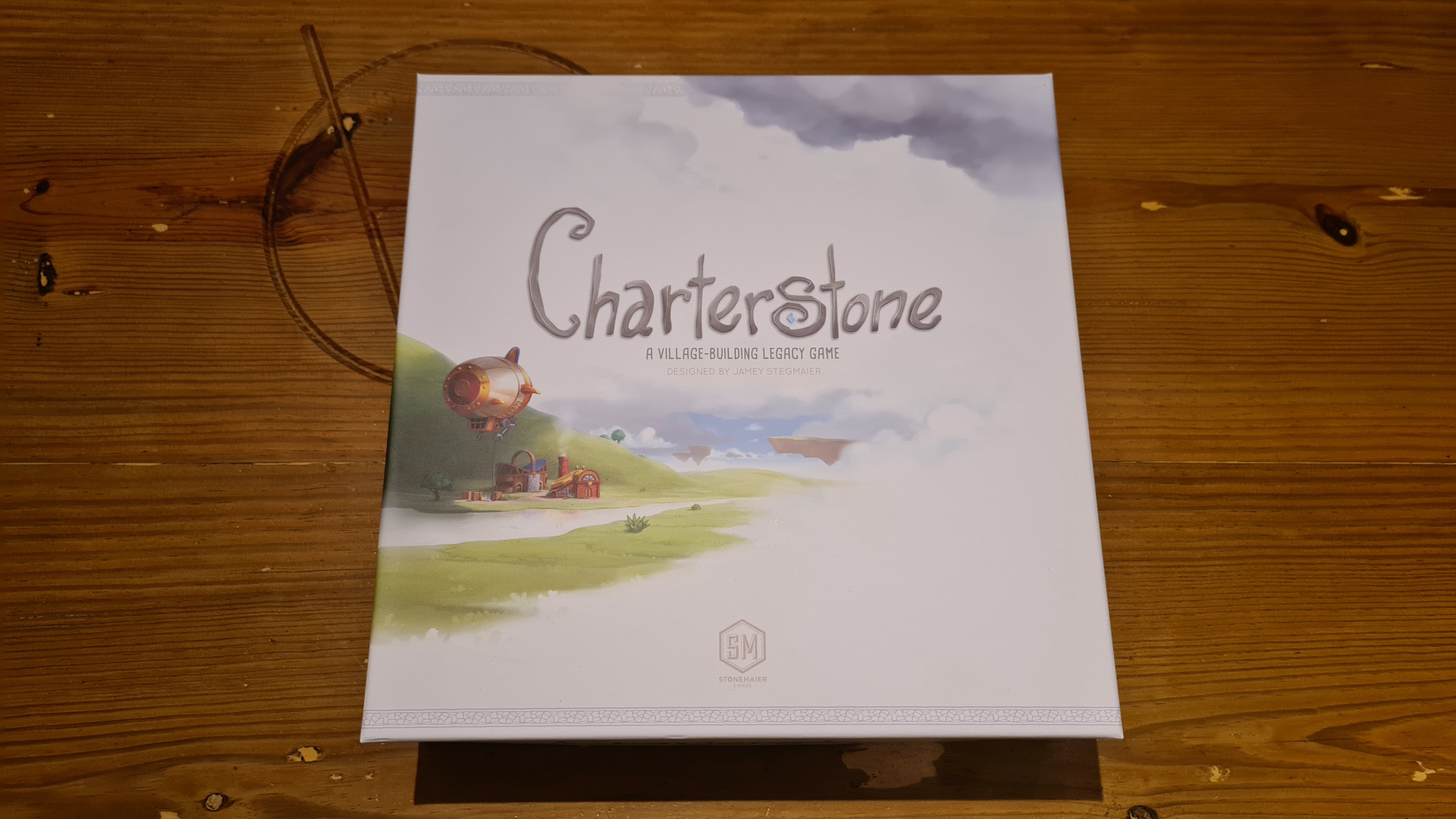Charterstone, released originally back in 2017, is a worker placement, legacy style board game from Stonemaier Games. Designed by Jamey Stegmaier, featuring artwork from Lina Cossette and David Forest, the game sees players tasked with growing a new village for the Forever King. Being a legacy game, content is unlocked as players journey through the experience, with aspects such as stickers added to the board permanently there from one game to the next. However, will players want to charter a route through the village expanding process? Let’s find out!
Before the first game players will choose one of the six charters, taking the box of components with the charter symbol. Included in each box are cards, two worker meeples and an initial persona card. The central board starts fairly bare, with key central locations, some standard track and a lot of spaces for stickers. Each game the progress token is placed onto the tracker, which counts down towards the end of a game when specific actions are performed by players.
On a turn players can either place a worker or retrieve all of their placed workers. With only two workers players will utilize both actions regularly, though there is meeple bumping. If you send a worker to an action space which is occupied it bumps the meeple back to the owner. This means action spaces cannot be fully blocked. Still, the dynamic created of potentially allowing an opponent to do more before having to retrieve workers makes players want to avoid doing so.
Action spaces will either be basic resources, constructed buildings or those in the commons. Sending a worker to a basic resource generating space sees the player gain the likes of pumpkins, wood and grain. Constructed buildings then have costs of coins and/or resources to perform actions. These actions could be as simple as gaining lots of money for resources, with more options slowly becoming available throughout the legacy experience. A number of the central action locations have an influence token cost. Running out of influence will speed up the end of the game but these are also often point scoring actions.

Going to the commons quota track sees the player able to spend resources for points, with bonuses available depending on the amounts spent. Placing influence into the reputation tracker will award those with the most influence there at the end of the game the most points. The zeppelin and charterstone locations are the most exciting though, advancing the progress token, bringing closer the end of game, but also being the core of the legacy experience.
Going to the zeppelin the player chooses one of their unconstructed building cards. Peeling off the building sticker they stick it to any of the empty spaces in their charter’s section of the board – with each player starting with five empty spaces alongside their basic resource generating building. Importantly, the card isn’t discarded. As a constructed building card it then represents a numbered crate that can be opened. Visiting the charterstone location players can unbox these crates, often getting new cards from the tuckbox and potentially unlocking secret legacy content.
The game continues with players taking turns clockwise around the table until the progress token reaches the end of the tracker. Importantly, it’ll have to travel further with increased player counts. Some of the spaces on the progress tracker feature bonuses, such as gaining reputation, which are awarded to the player that causes the token to be moved onto the indicated progress track space. This can result in players avoiding actions that would line another player up for a bonus. At the end of the game players gain points from reputation, glory and then potentially from the objective set out by the Forever King.

The winner of the game gets to colour in a trophy on their charter box, with points converting to stars. These are another of the legacy systems, gaining the player points for the overall campaign but also unlocking abilities such as to start all future games with a bonus coin, or being able to hold onto resources or more cards from one game to the next. Winning the games along the way will help towards winning the legacy campaign overall, though those that lose are given small boosts to make sure they don’t drop too far behind.
Charterstone is somewhat of a slow starter. For the first few games the experience is rather simple, with obvious aims. While the players have choices, there are a few obvious routes to points and hopefully victory. This sees players activating the same few action spaces over and over again and not branching out. There are choices though, such as which unconstructed buildings to construct and these start to impact things after a couple of games. As other legacy elements are introduced which buildings workers are sent to can be impacted but players need to almost get through the first couple of games before seeing this impact.
Without revealing any specifics, as a legacy experience the game evolves and changes as players journey through the loose storyline – which links games together and approximately explains some of the objectives given to players by the Forever King. Despite a few surprises along the way, with a new component coming out of the box, most felt like a natural small extension rather than a wow factor of a huge twist.
Part of this is the way that a few icons are on the board/player boxes before they are used. The other side of it is that a range of similar content is slowly unlocked, but once you’ve seen one you can guess roughly what the next handful of unlocks will look like. The exact abilities or uses of these components weren’t known, still the players knew they were going to be unlocked at some point.

Guideposts, which are the Forever King’s objectives, can at times massively swing the result of a game. While players are given the roughest idea of what that might be for, players can gain 30 odd points for them. While it meant a player that attempted to follow the King’s wishes could potentially snatch victory from a losing position it left a sour taste for those that were otherwise far ahead on points. Once this happened a couple of times though players certainly started to adhere to the guideposts more, giving the game direction and seeing players more likely to have overlapping interests.
Charterstone, like pretty much every other title in the Stonemaier catalogue, is a stunning production. From the vibrant main board, to the shaped resource tokens and metal coins, the game even when unboxing goes above and beyond most. Add in all the legacy elements and Charterstone only looks better: the stickers that add to the board, the tuckbox of legacy cards ready to be added into play, the tuckbox even has a magnetic close. It’s not just about looks though the board and cards are full of intuitive iconography, which keeps the board free of a lot of text and maintains the readability of the potential actions and such. Of course, production quality isn’t everything but it makes playing a good game that bit nicer, especially the clink of metal coins.
When it was released Charterstone was almost unfairly shot down. It was a legacy game at the peak of consumer interest in such games. It was from Stonemaier Games, designed by Jamey Stegmaier himself. The hype therefore was sky high and the game doesn’t quite hit those heights, despite offering a solid campaign, with slowly unlocking content. There are catch up mechanisms that mean no one player will pull out massively into the lead, and an evolving board with plenty of stickers and such to come out of the legacy deck. As a worker placement game it starts too simple and a bit slow, something that could put people off. After a few plays it gets going though and Charterstone becomes a fun worker placement game, with a board you have helped shape.
(Editor’s Note: Charterstone was provided to us by Asmodee for the review. It is currently available from local board game stores! Find your local store here.)

